User talk:2601:586:400:99B0:9076:1E54:B780:69BD
The Principate[edit]
27 BC–68 AD: Julio-Claudian dynasty[edit]
| Portrait | Name | Birth | Succession | Reign | Time in office | Death |
|---|---|---|---|---|---|---|

|
Augustus IMPERATOR CAESAR DIVI FILIVS AVGVSTVS |
September 23, 63 BC, Rome, Italia | Great-nephew and adopted son of Julius Caesar; became de facto emperor as a result of the 'first settlement' between himself and the Roman Senate. | January 16, 27 BC – August 19, 14 AD | 40 years, 7 months and 3 days | August 19, 14 AD (aged 75) Natural causes |

|
Tiberius TIBERIVS CAESAR DIVI AVGVSTI FILIVS AVGVSTVS |
November 16, 42 BC, Rome, Italia | Natural son of Livia Drusilla, Augustus' third wife, by a previous marriage; stepbrother and third husband of Julia the Elder, daughter of Augustus; adopted by Augustus as his son and heir. | September 18, 14 AD – March 16, 37 AD | 22 years, 5 months and 27 days | March 16, 37 AD (aged 77) Probably natural causes, possibly assassinated by Caligula or praetorian prefect Naevius Sutorius Macro |
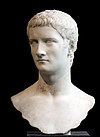
|
Caligula GAIVS IVLIVS CAESAR AVGVSTVS GERMANICVS |
August 31, 12 AD, Antium, Italia | Great-nephew and adoptive grandson of Tiberius; natural son of Germanicus; great-grandson of Augustus. | March 18, 37 AD – January 24, 41 AD | 3 years, 10 months and 6 days | January 24, 41 AD (aged 28) Assassinated in a conspiracy involving senators and Praetorian Guards. |

|
Claudius TIBERIVS CLAVDIVS CAESAR AVGVSTVS GERMANICVS |
August 1, 10 BC, Lugdunum, Gallia Lugdunensis | Uncle of Caligula; brother of Germanicus; nephew of Tiberius; great-nephew and step-grandson of Augustus; proclaimed emperor by the Praetorian Guard. | January 25/26, 41 AD – October 13, 54 AD | 13 years, 8 months and 18/19 days | October 13, 54 AD (aged 63) Probably poisoned by his wife Agrippina the Younger, in favour of her son Nero, possibly natural causes. |
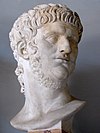
|
Nero NERO CLAVDIVS CAESAR AVGVSTVS GERMANICVS |
December 15, 37 AD, Antium, Italia | Great-nephew, stepson, son-in-law and adopted son of Claudius; nephew of Caligula; great-great-nephew of Tiberius; grandson of Germanicus; great-great-grandson of Augustus | October 13, 54 AD – June 9, 68 AD | 13 years, 7 months and 27 days | June 9, 68 AD (aged 30) Committed suicide after being declared a public enemy by the Senate. |
68–96: Year of the Four Emperors and Flavian dynasty[edit]
| Portrait | Name | Birth | Succession | Reign | Time in office | Death |
|---|---|---|---|---|---|---|

|
Galba IMPERATOR SERVIVS GALBA CAESAR AVGVSTVS |
December 24, 3 BC, Near Terrancilium, Italia | Seized power after Nero's suicide, with support of the Praetorian Guard | June 8, 68 AD – January 15, 69 AD | 7 months and 7 days | January 15, 69 AD (aged 72) Murdered by Praetorian Guard in coup led by Otho |
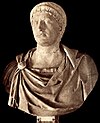
|
Otho IMPERATOR MARCVS SALVIVS OTHO CAESAR AVGUSTVS |
April 28, 32 AD, Ferentinum, Italia | Appointed by Praetorian Guard | January 15, 69 AD – April 16, 69 AD | 3 months and 1 day | April 16, 69 AD (aged 36) Committed suicide after losing Battle of Bedriacum to Vitellius |
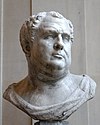
|
Vitellius IMPERATOR AVLVS VITELLIVS GERMANICVS AVGVSTVS |
September 24, 15 AD, Rome, Italia | Seized power with support of German Legions (in opposition to Galba/Otho) | April 17, 69 AD – December 20, 69 AD | 8 months and 3 days | December 20, 69 AD (aged 54) Murdered by Vespasian's troops |
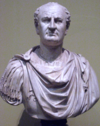
|
Vespasian IMPERATOR TITVS FLAVIVS CAESAR VESPASIANVS AVGVSTVS |
November 17, 9 AD, Falacrine, Italia | Seized power with the support of the eastern Legions (in opposition to Marcillinus) | December 21, 69 AD – June 24, 79 AD | 9 years, 6 months and 3 days | June 24, 79 AD (aged 69) Natural causes |

|
Titus IMPERATOR TITVS FLAVIVS CAESAR VESPASIANVS AVGVSTVS |
December 30, 39 AD, Rome, Italia | Son of Vespasian | June 24, 79 AD – September 13, 81 AD | 2 years, 2 months and 20 days | September 13, 81 AD (aged 41) Natural causes (fever) |

|
Domitian IMPERATOR TITVS FLAVIVS CAESAR DOMITIANVS AVGVSTVS GERMANICVS |
October 24, 51 AD, Rome, Italia | Brother of Titus; son of Vespasian | September 14, 81 AD – September 18, 96 AD | 15 years and 4 days | September 18, 96 AD (aged 44) Assassinated by court officials |
96–192: Nerva–Antonine dynasty[edit]
Note: all dates AD hereafter.
| Portrait | Name | Birth | Succession | Reign | Time in office | Death |
|---|---|---|---|---|---|---|

|
Nerva IMPERATOR MARCVS COCCEIVS NERVA CAESAR AVGVSTVS |
November 8, 30, Narni, Italia | Appointed by the Senate. First of the “Five Good Emperors”. | September 18, 96 – January 27, 98 | 1 year, 4 months and 9 days | January 27, 98 (aged 67) Natural causes |

|
Trajan IMPERATOR CAESAR NERVA TRAIANVS DIVI NERVAE FILIVS AVGVSTVS |
September 18, 53, Italica, Hispania Baetica | Adopted son and heir of Nerva. His reign marked the geographical peak of the empire | January 28, 98 – August 7, 117 | 19 years, 6 months and 10 days | August 7, 117 (aged 63) Natural causes |

|
Hadrian IMPERATOR CAESAR PVBLIVS AELIVS TRAIANVS HADRIANVS AVGVSTVS |
January 24, 76, Italica, Hispania Baetica (or Rome) | Adopted son and heir of Trajan | August 11, 117 – July 10, 138 | 20 years, 10 months and 30 days | July 10, 138 (aged 62) Natural causes |

|
Antoninus Pius IMPERATOR CAESAR TITVS AELIVS HADRIANVS ANTONINVS AVGVSTVS PIVS |
September 19, 86, Near Lanuvium, Italia | Adopted son and heir of Hadrian | July 10, 138 – March 7, 161 | 22 years, 6 months and 28 days | March 7, 161 (aged 74) Natural causes |

|
Lucius Verus IMPERATOR CAESAR LVCIVS AVRELIVS VERVS AVGVSTVS |
December 15, 130, Rome | Adopted son and heir of Antoninus Pius and son-in-law of Marcus Aurelius; Co-emperor with Marcus Aurelius until his death | March 7, 161 – ? March 169 | 8 years | March 169 (aged 39) Natural causes (Plague) |
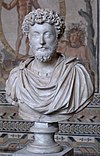
|
Marcus Aurelius IMPERATOR CAESAR MARCVS AVRELIVS ANTONINVS AVGVSTVS |
April 26, 121, Rome | Adopted son, son-in-law and heir of Antoninus Pius; Co-emperor with Lucius Verus until 169. Last of the “Five Good Emperors” | March 7, 161 – March 17, 180 | 19 years and 10 days | March 17, 180 (aged 58) Natural causes |

|
Commodus IMPERATOR CAESAR LUCIVS AELIVS AVRELIVS COMMODVS AVGVSTVS |
August 31, 161, Lanuvium, Italia | Natural son of Marcus Aurelius; joint emperor from 177 | March 17, 180 – December 31, 192 | 3 years as joint emperor, 12 years as sole emperor |
December 31, 192 (aged 31)
Assassinated in palace, strangled in his bath |
193–235: Year of the Five Emperors and Severan dynasty[edit]
| Portrait | Name | Birth | Succession | Reign | Time in office | Death |
|---|---|---|---|---|---|---|

|
Pertinax IMPERATOR CAESAR PVBLIVS HELVIVS PERTINAX AVGVSTVS |
August 1, 126, Alba, Italia | Proclaimed emperor by Praetorian Guard | January 1, 193 – March 28, 193 | 2 months and 27 days (86 days) | March 28, 193 (aged 66) Murdered by Praetorian Guard |
 |
Didius Julianus IMPERATOR CAESAR MARCVS DIDIVS SEVERVS IVLIANVS AVGVSTVS |
133 or 137, Milan, Italia | Won auction held by the Praetorian Guard for the position of emperor | March 28, 193 – June 1, 193 | 2 months and 4 days (65 days) | June 1, 193 (aged 56 or 60) Executed on orders of the Senate |

|
Septimius Severus IMPERATOR CAESAR LVCIVS SEPTIMIVS SEVERVS EVSEBES PERTINAX AVGVSTVS |
April 11, 145, Leptis Magna, Libya | Seized power with support of Pannonian legions[a] | April 9, 193 – February 4, 211 | 17 years, 9 months and 26 days | February 4, 211 (aged 65) Natural causes |
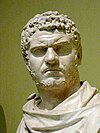
|
Caracalla IMPERATOR CAESAR MARCVS AVRELIVS ANTONINVS AVGVSTVS |
April 4, 188, Lugdunum, Gallia Lugdunensis | Son of Septimius Severus; co-emperor with Severus from 198; with Severus and Geta from 209 until February 211; co-emperor with Geta until December 211 | February 4, 211 – April 8, 217 | 13 years as joint emperor 10 months with Geta 6 years as sole emperor |
April 8, 217 (aged 29) Murdered by a soldier as part of a conspiracy involving Macrinus |

|
Geta IMPERATOR CAESAR PVBLIVS SEPTIMIVS CETA AVGVSTUS |
March 7, 189, Rome | Son of Septimius Severus; co-emperor with Severus and Caracalla from 209 until February 211; co-emperor with Caracalla until December 211 | February 4, 211 – December 26, 211 | 2 years as joint emperor 10 months with Caracalla |
December 19, 211 (aged 22) Murdered on the orders of Caracalla |
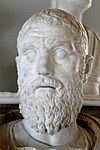 
|
Macrinus IMPERATOR CAESAR MARCVS OPELLIVS SEVERVS MACRINVS AVGVSTVS with Diadumenian IMPERATOR CAESAR MARCVS OPELLIVS ANTONINVS DIADVMENIANVS AVGVSTVS |
c. 165, Caesarea, Mauretania | Praetorian Prefect to Caracalla, probably conspired to have Caracalla murdered and proclaimed himself emperor after Caracalla's death; made his son Diadumenian (born on 14 September 208) co-emperor in May 218 | April 11, 217 – June 8, 218 | 1 year, 1 month and 28 days | June 8, 218 (aged 53) Both executed in favour of Elagabalus |
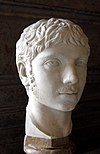
|
Elagabalus IMPERATOR CAESAR MARCVS AVRELIVS ANTONINVS AVGVSTVS |
c. 204, Emesa, Syria | Grandnephew of Septimius Severus, first cousin once removed and alleged illegitimate son of Caracalla; proclaimed emperor by Syrian legions | June 8, 218 – March 11, 222 | 3 years, 9 months and 3 days | March 11, 222 (aged 18) Murdered by Praetorian Guard |
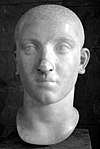
|
Severus Alexander IMPERATOR CAESAR MARCVS AVRELIVS SEVERVS ALEXANDER AVGVSTVS |
c. 208, Arca Caesarea, Syria | Grandnephew of Septimius Severus, cousin and adoptive heir of Elagabalus | March 13, 222 – March 18, 235 | 13 years and 5 days | March 18, 235 (aged 27) Murdered by the army |
235–285: Gordian dynasty and Crisis of the Third Century[edit]
| Portrait | Name | Birth | Succession | Reign | Time in office | Death |
|---|---|---|---|---|---|---|
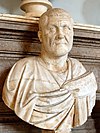
|
Maximinus Thrax IMPERATOR CAESAR GAIVS IVLIVS VERVS MAXIMINVS AVGVSTVS |
c. 173, Thrace or Moesia | Proclaimed emperor by Germanic legions after the murder of Severus Alexander | March 20, 235 – June 238 | 3 years, 3 months | June 238 (aged 65) Assassinated by his men during the siege of Aquileia |

|
Gordian I IMPERATOR CAESAR MARCVS ANTONIVS CORDIANVS SEMPRONIANVS ROMANVS AFRICANVS AVGVSTVS |
c. 159, Phrygia? | Proclaimed emperor, whilst Pro-consul in Africa, during a revolt against Maximinus. Ruled jointly with his son Gordian II, and in opposition to Maximinus. Technically a usurper, but retrospectively legitimised by the accession of Gordian III | March 22, 238 – April 12, 238 | 21 days | April 238 (aged 79) Committed suicide upon hearing of the death of Gordian II. |
 |
Gordian II IMPERATOR CAESAR MARCVS ANTONIVS CORDIANVS SEMPRONIANVS ROMANVS AFRICANVS AVGVSTVS |
c. 192, ? | Proclaimed emperor, alongside father Gordian I, in opposition to Maximinus by act of the Senate. | March 22, 238 – April 12, 238 | 21 days | April 238 (aged 46) Killed during the Battle of Carthage, fighting a pro-Maximinus army |
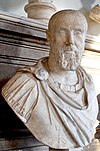
|
Pupienus IMPERATOR CAESAR MARCVS CLODIVS PVPIENVS MAXIMVS AVGVSTVS |
c. 165 or 170 | Proclaimed joint emperor with Balbinus by the Senate in opposition to Maximinus; later co-emperor with Balbinus. | April 22, 238 – July 29, 238 | 3 months and 7 days | July 29, 238 (aged 68 or 73) Assassinated by the Praetorian Guard |

|
Balbinus IMPERATOR CAESAR DECIMVS CAELIVS CALVINVS BALBINVS PIVS AVGVSTVS |
178 | Proclaimed joint emperor with Pupienus by the Senate after death of Gordian I and II, in opposition to Maximinus; later co-emperor with Pupienus and Gordian III | April 22, 238 – July 29, 238 | 3 months and 7 days | July 29, 238 (aged 60) Assassinated by Praetorian Guard |
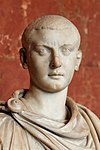
|
Gordian III IMPERATOR CAESAR MARCVS ANTONIVS CORDIANVS PIVS AVGVSTVS |
January 20, 225, Rome | Proclaimed emperor by supporters of Gordian I and II, then by the Senate; joint emperor with Pupienus and Balbinus until July 238; grandson and nephew of Gordian I and II, respectively | April 22, 238 – February 11, 244 | 5 years, 9 months and 20 days | February 11, 244 (aged 19) Unknown; possibly murdered on orders of Philip I |
 
|
Philip the Arab IMPERATOR CAESAR MARCVS IVLIVS PHILIPPVS AVGVSTVS with IMPERATOR CAESAR MARCVS IVLIVS SEVERVS PHILLIPVS AVGVSTVS |
c. 204, Shahba, Syria | Praetorian Prefect to Gordian III, took power after his death; made his son Philip II (born 237) co-emperor in summer 247 | February 244 – September/October 249 | 5 years | September/October 249 (aged 45) Killed in the Battle of Verona by Decius, Philip II murdered by the Praetorian Guard |
 
|
Decius IMPERATOR CAESAR CAIVS MESSIVS QVINTVS TRAIANVS DECIVS AVGVSTVS with IMPERATOR CAESAR QVINTVS HERENNIVS ETRVSCVS MESSIVS DECIVS AVGVSTVS |
c. 201, Budalia, Pannonia Inferior | Governor under Philip the Arab; proclaimed emperor by Danubian legions then defeating and killing Philip in the Battle of Verona; made his son Herennius Etruscus (born 227) co-emperor in early 251 | September/ October 249 – June 251 | 2 years | June 251 (aged 50) Both killed in the Battle of Abrittus fighting against the Goths |
 |
Hostilian IMPERATOR CAESAR CAIVS VALENS HOSTILIANVS MESSIVS QVINTVS AVGVSTVS |
Sirmium | Son of Decius, accepted as heir by the Senate | June 251 – late 251 | 4–5 months | September/October 251 (aged 21) Natural causes (plague) |
 
|
Trebonianus Gallus IMPERATOR CAESAR GAIVS VIBIVS AFINIVS TREBONIANVS GALLVS AVGVSTVS with IMPERATOR CAESAR GAIVS VIBIVS VOLVSIANVS AVGVSTVS |
206, Italia | Governor of Moesia Superior, proclaimed emperor by Danubian legions after Decius's death (and in opposition to Hostilian); made his son Volusianus co-emperor in late 251. | June 251 – August 253 | 2 years | August 253 (aged 47) Assassinated by their own troops, in favour of Aemilian |
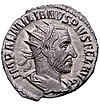
|
Aemilian IMPERATOR CAESAR MARCVS AEMILIVS AEMILIANVS AVGVSTVS |
c. 207 or 213 Africa | Governor of Moesia Superior, proclaimed emperor by Danubian legions after defeating the Goths; accepted as emperor after death of Gallus | August 253 – October 253 | 2 months | September/October 253 (aged 40 or 46) Assassinated by his own troops, in favour of Valerian |
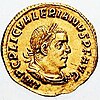 |
Valerian IMPERATOR CAESAR PVBLIVS LICINIVS VALERIANVS AVGVSTVS |
c. 195 | Governor of Noricum and Raetia, proclaimed emperor by Rhine legions after death of Gallus; accepted as emperor after death of Aemilian | October 253 – 260 | 7 years | After 260 (aged at least 65) Captured in Battle of Edessa against Persians, died in captivity |
 
|
Gallienus IMPERATOR CAESAR PVBLIVS LICINIVS EGNATIVS GALLIENVS AVGVSTVS with IMPERATOR CAESAR CORNELIVS LICINIVS SALONINVS VALERIANVS PIVS FELIX INVICTVS AVGVSTVS |
218 | Son of Valerian, made co-emperor in 253; his son Saloninus (born c. 242) is very briefly co-emperor in c. July 260 before assassination by Postumus. | October 253 – September 268 | 15 years | September 268 (aged 50) Murdered at Aquileia by his own commanders. |
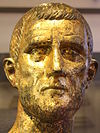 |
Claudius Gothicus IMPERATOR CAESAR MARCVS AVRELIVS VALERIVS CLAVDIVS AVGVSTVS |
May 10, 210, Sirmium | Victorious general at Battle of Naissus, seized power after Gallienus's death | September 268 – January 270 | 1 year, 4 months | January 270 (aged 60) Natural causes (plague) |
 |
Quintillus IMPERATOR CAESAR MARCVS AVRELIVS CLAVDIVS QVINTILLVS AVGVSTVS |
c.210, Sirmium | Brother of Claudius II, seized power after his death | January 270 – September(?) 270 | Unknown | 270 (aged around 60) Unclear; possibly suicide or murder |
 |
Aurelian IMPERATOR CAESAR LVCIVS DOMITIVS AVRELIANVS AVGVSTVS |
September 9, 214/215, Sirmium | Proclaimed emperor by Danubian legions after Claudius II's death, in opposition to Quintillus | September(?) 270 – September 275 | 5 years | September 275 (aged 60-61) Assassinated by Praetorian Guard |

|
Ulpia Severina VLPIA SEVERINA PIA AVGVSTA |
Unknown | Wife of Aurelian, there is evidence that she ruled in her own right during the interregnum between Aurelian's death and the election of Tacitus.[1][2] | September 275 | Briefly | Unknown |

|
Tacitus IMPERATOR CAESAR MARCVS CLAVDIVS TACITVS AVGVSTVS |
c. 200, Interamna Nahars, Italia | Elected by the Senate to replace Aurelian, after a short interregnum | September 25, 275 – June 276 | 9 months | June 276 (aged 76) Natural causes (possibly assassinated) |
 |
Florianus IMPERATOR CAESAR MARCVS ANNIVS FLORIANVS AVGVSTVS |
? | Brother of Tacitus, elected by the army in the west to replace him | June 276 – September? 276 | 3 months | September? 276 (aged ?) Assassinated by his own troops, in favour of Probus |

|
Probus IMPERATOR CAESAR MARCVS AVRELIVS PROBVS AVGVSTVS |
232, Sirmium | Governor of the eastern provinces, proclaimed emperor by Danubian legions in opposition to Florian | September? 276 – September/ October 282 | 6 years | September/ October 282 (aged 50) Assassinated by his own troops, in favour of Carus |

|
Carus IMPERATOR CAESAR MARCVS AVRELIVS CARVS AVGVSTVS |
c. 230, Narbo, Gallia Narbonensis | Praetorian Prefect to Probus; seized power either before or after Probus was murdered; made his son Carinus co-emperor in early 283 | September/ October 282 – late July/ early August 283 | 10–11 months | Late July/August 283 (aged 61) Probably natural causes (Possibly killed by lightning) |
 |
Carinus CAESAR MARCVS AVRELIVS CARINVS AVGVSTVS |
? | Son of Carus, ruled shortly with him (from early 283) as co-emperor and then in his own right with his brother Numerian | Late July/early August 283 – 285 | 2 years | 285 (aged ?) Probably died in battle against Diocletian |
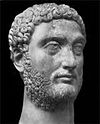 |
Numerian IMPERATOR CAESAR MARCVS AVRELIVS NVMERIVS NVMERIANVS AVGVSTVS |
? | Son of Carus, succeeded him jointly with his brother Carinus | Late July/early August 283 – 284? | 1 year | 284 (aged ?) Unclear; possibly assassinated |
The Dominate[edit]
284–364: Tetrarchy and Constantinian dynasty[edit]
Note: To maintain control and improve administration, various schemes to divide the work of the Roman Emperor by sharing it between individuals were tried after 285. The "Tetrarchy" proclaimed by Diocletian in 293 split the empire into two halves each to be ruled separately by two emperors, a senior "Augustus", and a junior "Caesar".
| Portrait | Name | Birth | Succession | Reign | Time in office | Death |
|---|---|---|---|---|---|---|

|
Diocletian IMPERATOR CAESAR CAIVS AVRELIVS VALERIVS DIOCLETIANVS AVGVSTVS
then, after 286 (EAST) |
c. December 22, 244, Salona | Proclaimed emperor by army after death of Numerian, and in opposition to Carinus; adopted Maximian as senior co-emperor in 286 | November 20, 284 – May 1, 305 | 20 years, 5 months and 11 days | 3 December 311 (aged 67) Abdicated; died of natural causes in Aspalatos |
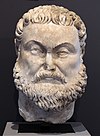
|
Maximian IMPERATOR CAESAR MARCVS AVRELIVS VALERIVS MAXIMIANVS HERCVLIVS AVGVSTVS
|
c. 250, near Sirmium, Pannonia | Adopted as senior co-emperor ('Augustus') in the west by Diocletian in 286 | April 1, 286 – May 1, 305 | 19 years and 1 month | 310 (aged 60) Abdicated with Diocletian; twice tried to regain throne with, and then from Maxentius; captured by Constantine I and committed suicide at his behest |
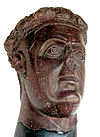
|
Galerius IMPERATOR CAESAR GAIVS GALERIVS VALERIVS MAXIMIANVS AVGVSTVS
|
c. 250, Felix Romuliana, Moesia Superior | Adopted as junior co-emperor ('Caesar') and heir by Diocletian in 293. Also son-in-law of Diocletian. | May 1, 305 – May 311 | 6 years | 311 (aged 61) Natural causes |
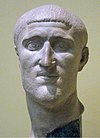
|
Constantius Chlorus IMPERATOR CAESAR MARCVS FLAVIVS VALERIVS CONSTANTIVS HERCVLIVS AVGVSTVS
|
March 31, c. 250, Dardania, Moesia | Adopted as junior co-emperor ('Caesar') and heir by Maximian in 293 | May 1, 305 – July 25, 306 | 1 year, 2 months and 24 days | 306 (aged 56) Natural causes |
 |
Valerius Severus IMPERATOR CAESAR FLAVIVS VALERIVS SEVERVS AVGVSTVS
|
? | Adopted as junior co-emperor ('Caesar') and heir by Constantius Chlorus in 305; succeeded as Augustus in 306; opposed by Maxentius and Constantine I | Summer 306 – March/ April 307 | 1 year | September 16, 307 (aged ?) Captured by Maxentius and forced to commit suicide (or murdered) |

|
Constantine the Great IMPERATOR CAESAR FLAVIVS VALERIVS AVRELIVS CONSTANTINVS AVGVSTVS
then, after 324 (EAST and WEST) |
February 27, c. 272, Naissus, Moesia Superior | Son of Constantius I Chlorus, proclaimed emperor by his father's troops; accepted as Caesar (west) by Galerius in 306; promoted to Augustus (west) in 307 by Maximian after death of Severus II; refused relegation to Caesar in 309 | July 25, 306 – May 22, 337 | 30 years, 9 months and 27 days | May 22, 337 (aged 65) Natural causes |
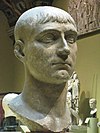
|
Maxentius IMPERATOR CAESAR MARCVS AVRELIVS VALERIVS MAXENTIVS AVGVSTVS
|
c. 276 | Son of Maximian, seized power in 306 after death of Constantius I Chlorus, in opposition to Severus and Constantine I; made Caesar (west) by Maximian in 307 after the death of Severus | October 28, 306 – October 28, 312 | 6 years | October 28, 312 (aged 36) Died at the Battle of the Milvian Bridge, against Constantine I |
  
|
Licinius IMPERATOR CAESAR CAIVS VALERIVS LICINIANVS LICINIVS AVGVSTVS
IMPERATOR CAESAR AVRELIVS VALERIVS VALENS AVGVSTVS and IMPERATOR CAESAR SEXTVS MARCIVS MARTININANVS AVGVSTVS |
c. 263, Felix Romuliana, Moesia Superior | Son-in-law of Constantius Chlorus, appointed Augustus in the west by Galerius in 308, in opposition to Maxentius; became Augustus in the east in 311 after the death of Galerius (shared with Maximinus II); defeated Maximinus II in civil war to become sole eastern Augustus in 313; appointed Valerius Valens in 317, and Martinian in 324 as western Augustus, in opposition to Constantine, both being executed within weeks. | November 11, 308 – September 18, 324 | 15 years, 10 months and 7 days | 325 (aged 61/62) Defeated in civil war against Constantine I in 324 and captured; executed on the orders of Constantine the next year |
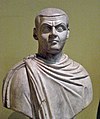
|
Maximinus II IMPERATOR CAESAR CAIVS CALERIVS VALERIVS MAXIMINVS AVGVSTVS
|
November 20, c. 270, Dacia Aureliana | Nephew of Galerius, adopted as Caesar and his heir in 305; succeeded as Augustus (shared with Licinius I) in 311 | May 1, 311 – July/August 313 | 2 years | July/August 313 (aged 42) Defeated in civil war against Licinius; probably committed suicide thereafter |

|
Constantine II IMPERATOR CAESAR FLAVIVS CLAVDIVS CONSTANTINVS AVGVSTVS
|
316, Arelate, Gallia Narbonensis | Son of Constantine I; appointed Caesar in 317, succeeded as joint Augustus with his brothers Constantius II and Constans I | May 22, 337 – 340 | 3 years | 340 (aged 24) Died in battle against Constans I |

|
Constantius II IMPERATOR CAESAR FLAVIVS IVLIVS CONSTANTIVS AVGVSTVS
then, after 353 (EAST and WEST) |
August 7, 317, Sirmium, Pannonia | Son of Constantine I; succeeded as joint Augustus with his brothers Constantine II and Constans I; sole emperor from 350 | May 22, 337 – November 3, 361 | 24 years, 5 months and 12 days | 361 (aged 44) Natural causes |
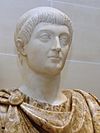
|
Constans I IMPERATOR CAESAR FLAVIVS IVLIVS CONSTANS AVGVSTVS
then, after 340 (WEST) |
c. 323 | Son of Constantine I; succeeded as joint Augustus with his brothers Constantine II and Constantius II | May 22, 337 – 350 | 13 years | 350 (aged 27) Assassinated on the orders of the usurper Magnentius |
 |
Vetranio IMPERATOR CAESAR FLAVIVS VETRANIO AVGVSTVS
|
?, Moesia | General of Constans, proclaimed Caesar against Magnentius and temporarily accepted as Augustus of the west by Constantius II. | March 1, 350 – December 25, 350 | 9 months and 24 days | c. 356 (aged ?) As a private citizen, after abdication. |
 |
Julian IMPERATOR CAESAR FLAVIVS CLAVDIVS IVLIANVS AVGVSTVS
then, after 361 (EAST and WEST) |
331/332, Constantinople, Thracia | Cousin of Constantius II; made Caesar of the west in 355; proclaimed Augustus by his troops in 360; sole emperor after the death of Constantius | February 360 – June 26, 363 | 3 years | June 26, 363 (aged 31/32) Mortally wounded in battle |

|
Jovian IMPERATOR CAESAR FLAVIVS IOVIANVS AVGVSTVS
|
331, Singidunum, Moesia | General of Julian's army; proclaimed emperor by the troops on Julian's death | June 26, 363 – February 17, 364 | 7 months and 22 days | February 17, 364 (aged 33) Natural causes (suffocated on fumes) |
364–392: Valentinian dynasty[edit]
| Portrait | Name | Birth | Succession | Reign | Time in office | Death |
|---|---|---|---|---|---|---|

|
Valentinian I IMPERATOR CAESAR FLAVIVS VALENTINIANVS AVGVSTVS
then (WEST) |
321, Cibalae, Pannonia | Elected to replace Jovian by the army | February 26, 364 – November 17, 375 | 11 years, 8 months and 22 days | November 17, 375 (aged 54) Natural causes |
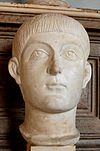
|
Valens IMPERATOR CAESAR FLAVIVS IVLIVS VALENS AVGVSTVS
|
328, Cibalae, Pannonia | Brother of Valentinian I, appointed co-augustus (for the east) by him | March 28, 364 – August 9, 378 | 14 years, 4 months and 12 days | August 9, 378 (aged 50) Killed in Battle of Adrianople against the Goths |

|
Gratian IMPERATOR CAESAR FLAVIVS GRATIANVS AVGVSTVS
|
April 18/May 23, 359, Sirmium, Pannonia | Son of Valentinian I, appointed junior Augustus by him in 367, became senior Augustus (for the west) after Valentinian's death. | August 4, 367 – August 25, 383 | 16 years and 21 days | August 25, 383 (aged 24) Murdered by rebellious army faction |
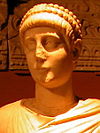
|
Valentinian II IMPERATOR CAESAR FLAVIVS VALENTINIANVS AVGVSTVS
|
371, Milan, Italia | Son of Valentinian I, proclaimed emperor by Pannonian army after Valentinian's death; accepted as co-Augustus for the west by Gratian | November 17, 375 – May 15, 392 | 16 years, 5 months and 28 days | May 15, 392 (aged 21) Unclear; possibly murdered or committed suicide |
| Portrait | Name | Birth | Succession | Reign | Time in office | Death |
|---|---|---|---|---|---|---|
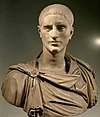 
|
Magnus Maximus
IMPERATOR CAESAR FLAVIVS MAGNVS MAXIMVS AVGVSTVS (WEST)
IMPERATOR CAESAR FLAVIVS VICTOR AVGVSTVS |
c. 335, Hispania | Usurper in the West; legitimized along with his son Victor by Theodosius I as emperors of Britannia and Gaul. | 383/384 – August 28, 388 | 4/5 years | August 28, 388 (aged 53) Executed by Theodosius I in Aquileia after the Battle of the Save; Victor killed by Arbogast |
| Portrait | Name | Birth | Succession | Reign | Time in office | Death |
|---|---|---|---|---|---|---|
 |
Eugenius
IMPERATOR CAESAR FLAVIVS EVGENIVS AVGVSTVS (WEST) |
? | Usurper in the West; elevated to emperor by Arbogast. | August 22 392 – September 6, 394 | 2 years, 15 days | September 6, 394 Executed as a criminal by Theodosius I near the Frigidus river |
Western Emperors[edit]
392–455: Theodosian dynasty[edit]
Note: Theodosius I was the last person to rule both halves of the Roman Empire, dividing the administration between his sons Arcadius and Honorius on his death.
| Portrait | Name | Birth | Succession | Reign | Time in office | Death |
|---|---|---|---|---|---|---|
 |
Theodosius I IMPERATOR CAESAR FLAVIVS THEODOSIVS AVGVSTVS |
January 11, 347, Cauca or Italica, Hispania | Son-in-law of Valentinian I, appointed as Augustus for the east by Gratian after the death of Valens; became sole senior Augustus after death of Valentinian II (Eastern Emperor since 379) | May 15, 392 – January 17, 395 | 2 years, 8 months and 2 days | January 17, 395 (aged 48) Natural causes |

|
Honorius IMPERATOR CAESAR FLAVIVS HONORIVS AVGVSTVS |
September 9, 384 | Son of Theodosius I; appointed as junior Augustus for the west by Theodosius on January 23, 393 (after the death of Valentinian II); became senior Augustus for the west after his father's death | January 17, 395 – August 15, 423 | 28 years, 6 months and 29 days | August 15, 423 (aged 38) Natural causes |
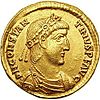 
|
Constantine III
IMPERATOR CAESAR FLAVIVS CLAVDIVS CONSTANTINVS AVGVSTVS IMPERATOR CAESAR FLAVIVS CONSTANS AVGVSTVS |
? | Usurper who declared himself emperor in the west in 407, recognized as co-emperor by Honorius in 409. Elevated his son Constans II to co-emperor in 409, who was not recognized by Honorius. Neither recognized by the Eastern Empire. | 407/409 - August or September 411 | 2 years | August or September 411 (aged ?) Executed by Constantius III |
 |
Constantius III IMPERATOR CAESAR FLAVIVS CONSTANTIVS AVGVSTVS |
?, Naissus, Moesia Superior | Married to Theodosius I's daughter Galla Placidia, elevated to co-Augustus for the west by Honorius; not recognized by the Eastern Empire | February 8, 421 – September 2, 421 | 6 months and 25 days | September 2, 421 (aged ?) Natural causes |
 |
Joannes
IMPERATOR CAESAR IOHANNES AVGVSTVS |
? | A senior civil servant under Honorius, proclaimed emperor by Castinus; not recognized by the Eastern Empire | August 27, 423 – May 425 | 2 years | June or July 425 (aged ?) Defeated in battle by Theodosius II and Valentinian III, captured and executed |
 |
Valentinian III IMPERATOR CAESAR FLAVIVS PLACIDIVS VALENTINIANVS AVGVSTVS |
July 2, 419, Ravenna, Italia | Son of Constantius III, appointed Caesar for the west by Theodosius II after the death of Honorius, in opposition to the regime of Joannes; became Augustus for the west after the defeat of Joannes | October 23, 424 – March 16, 455 | 30 years, 4 months and 21 days | March 16, 455 (aged 35) Assassinated, possibly at the behest of Petronius Maximus |
455–476: Last emperors of the Western Empire[edit]
| Portrait | Name | Birth | Succession | Reign | Time in office | Death |
|---|---|---|---|---|---|---|
 |
Petronius Maximus IMPERATOR CAESAR FLAVIVS ANICIVS PETRONIVS MAXIMVS AVGVSTVS |
c. 396 | Son-in-law of Theodosius II, proclaimed himself emperor with the support of the army, after the death of Valentinian III. Not recognized by the Eastern Empire. He appointed his son Palladius as caesar. | March 17, 455 – May 31, 455 | 2 months and 14 days | May 31, 455 (aged 58/59) Murdered, probably stoned to death by the Roman mob |
 |
Avitus IMPERATOR CAESAR MARCVS MAECILIVS FLAVIVS EPARCHIVS AVITVS AVGVSTVS |
c. 385 | Magister militum under Petronius Maximus, proclaimed emperor by the Visigoth king Theoderic II after Petronius's death. Not recognized by the Eastern Empire. | July 9, 455 – October 17, 456 | 1 year, 3 months and 8 days | after 17 October 456 (aged 71) Deposed by his Magister militum, Ricimer; became bishop of Placentia; murdered at some point afterwards |
 |
Majorian IMPERATOR CAESAR FLAVIVS IVLIVS VALERIVS MAIORIANVS AVGVSTVS |
November 420 | Proclaimed emperor by his troops. Recognized by the Eastern Empire at the behest of Ricimer. | April 457 – August 2, 461 | 4 years | August 7, 461 (aged 40) Deposed and beheaded on the orders of Ricimer. |
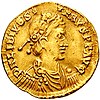 |
Libius Severus IMPERATOR CAESAR FLAVIVS LIBIVS SEVERVS SERPENTIVS AVGVSTVS |
?, Lucania, Italia | Appointed emperor by Ricimer. Not recognized by the Eastern Empire. | November 461 – August 465 | 4 years | August 465 (aged 45) Probably poisoned by Ricimer |

|
Anthemius IMPERATOR CAESAR PROCOPIVS ANTHEMIVS AVGVSTVS |
c. 420 | Son-in-law of Marcian, appointed emperor by Leo I, with the consent of Ricimer. | April 12, 467 – July 11, 472 | 5 years, 2 months and 29 days | July 11, 472 (aged 52) Executed by Ricimer or Gundobad (Ricimer's nephew). |
 |
Olybrius IMPERATOR CAESAR ANICIVS OLYBRIVS AVGVSTVS |
c. 420 | Son-in-law of Valentinian III; appointed emperor by Ricimer. Not recognized by the Eastern Empire. | July 11, 472 – November 2, 472 | 3 months and 22 days | November 2, 472 (aged 41) Natural causes |
 |
Glycerius IMPERATOR CAESAR FLAVIVS GLYCERIVS AVGVSTVS |
? | Appointed emperor by Gundobad (Ricimer's successor). Not recognized by the Eastern Empire. | March 473 – June 474 | 1 year | after 480 (aged ?) Deposed by Julius Nepos, became Bishop of Salona, time and manner of death unknown |

|
Julius Nepos IMPERATOR CAESAR FLAVIVS IVLIVS NEPOS AVGVSTVS |
c. 430 | Nephew-in-law of the eastern emperor Leo I (and nephew of Marcellinus) appointed emperor in opposition to Glycerius | June 474 – August 28, 475 (in Italy); – spring 480 (in Gaul and Dalmatia) | 1 year/6 years | 480 (aged 50) Deposed in Italy by Orestes, ruled in balance of Western Empire until assassination in 480. Maintained as figurehead in Italy by Odoacer to his death in 480. |

|
Romulus Augustulus IMPERATOR CAESAR FLAVIVS ROMVLVS AVGVSTVS |
c. 460[b] | Appointed by his father, Orestes. Listed as an emperor by historical convention. His rule never extended beyond portions of the Italian peninsula. Not recognized by Eastern Emperor Zeno. | October 31, 475 – September 4, 476 (in Italy) | 10 months and 4 days | Unknown. Deposed by Odoacer, who then ruled in the name of Julius Nepos until the latter's death in 480, which formally ended the separate Western Empire; most likely lived out his life in obscurity on a private villa. |
Note: The classical Roman Empire is usually said to have ended with the deposition of Romulus Augustulus, with its continuation in the East referred to by modern scholars as the Byzantine Empire.
Eastern Emperors[edit]
379–457: Theodosian dynasty[edit]
Note: Theodosius I was the last person to rule both halves of the Roman Empire, dividing the administration between his sons Arcadius and Honorius on his death.
| Portrait | Name | Birth | Succession | Reign | Time in office | Death |
|---|---|---|---|---|---|---|
 |
Theodosius I IMPERATOR CAESAR FLAVIVS THEODOSIVS AVGVSTVS |
January 11, 347, Cauca or Italica, Hispania | Son-in-law of Valentinian I, appointed as Augustus for the east by Gratian after the death of Valens; became sole senior Augustus after death of Valentinian II | January 19, 379 – January 17, 395 | 16 years and 16 days | January 17, 395 (aged 48) Natural causes |
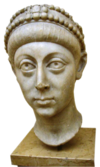 |
Arcadius IMPERATOR CAESAR FLAVIVS ARCADIVS AVGVSTVS |
c. 377, Hispania | Son of Theodosius I; appointed as junior Augustus for the east by Theodosius in January 383; became senior Augustus for the east after his father's death | January 17, 395 – May 1, 408 | 13 years | May 1, 408 (aged 31) Natural causes |
 |
Theodosius II IMPERATOR CAESAR FLAVIVS THEODOSIVS IVNIOR AVGVSTVS |
April 10, 401, Constantinople | Son of Arcadius; appointed as junior Augustus for the east by Arcadius in 402; became senior Augustus for the east after his father's death | January 402 – July 28, 450 | 48 years | July 28, 450 (aged 49) Injuries suffered during a hunting accident |
 |
Pulcheria IMPERATRIX AELIA PVLCHERIA AVGVSTA |
January 19, 398, Constantinople | Daughter of Arcadius and sister of Theodosius II; reigned as co-empress with the younger Theodosius II through his reign from 414 onwards, sole ruler of the empire upon his death as Augusta and Imperatrix | July 28, 450 – July, 453 | 3 years | July, 453 (aged 55) Cause unknown |
 |
Marcian IMPERATOR CAESAR FLAVIVS MARCIANVS AVGVSTVS |
396, Thrace or Illyria | Nominated as successor (and husband) by Pulcheria, ruled alongside her 450-453 and later alone | November 25, 450 – January 25, 457 | 7 years | January 457 (aged 65) Gout |
457–518: Leonid dynasty[edit]
| Portrait | Name | Birth | Succession | Reign | Time in office | Death |
|---|---|---|---|---|---|---|

|
Leo I the Thracian IMPERATOR CAESAR FLAVIVS VALERIVS LEO AVGVSTVS |
c. 400, Dacia | Chosen by the army | 7 February 457 – 18 January 474 | 17 years | 18 January 474 (aged 73) Dysentery |

|
Leo II IMPERATOR CAESAR FLAVIVS LEO AVGVSTVS |
c. 467, Constantinople | Grandson of Leo I | 18 January – 17 November 474 | 9 months | 17 November 474 (aged 7) Cause unknown, possibly poisoned |

|
Zeno IMPERATOR CAESAR FLAVIVS ZENO AVGVSTVS |
c. 425, Isauria | Named co-emperor by his son Leo II on 9 February 474. | 17 November 474 – 9 April 491 | 17 years | 9 April 491 (aged 66) Dysentery or epilepsy |

|
Basiliscus IMPERATOR CAESAR FLAVIVS BASILISCVS AVGVSTVS
IMPERATOR CAESAR FLAVIVS MARCVS AVGVSTVS |
? | Seized throne from Zeno, Basiliscus appointed his son Marcus co-emperor at some point in 475. | 9 January 475 – August 476 | 1 year, 7 months | 476/477
Starved to death in Limnae (in Cappadocia) by Zeno |
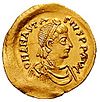
|
Anastasius I Dicorus IMPERATOR CAESAR FLAVIVS ANASTASIVS AVGVSTVS |
c. 430, Dyrrhachium | Son-in-law of Leo I | 11 April 491 – 9 July 518 | 27 years | 9 July 518 (aged 87) Natural causes |
518–602: Justinian dynasty[edit]
| Portrait | Name | Birth | Succession | Reign | Time in office | Death |
|---|---|---|---|---|---|---|
 |
Justin I IMPERATOR CAESAR FLAVIVS IVSTINVS AVGVSTVS |
c. 450 at Bederiana (Justiniana Prima), Dardania | Elected by army | July 518 – 1 August 527 | 9 years | 1 August 527 (aged 77) Natural causes |
 |
Justinian I IMPERATOR CAESAR FLAVIVS PETRVS SABBATIVS IVSTINIANVS AVGVSTVS |
c. 482 at Tauresium (Taor), Dardania | Nephew of Justin I | 1 August 527 – 13/14 November 565 | 38 years | 13/14 November 565 (aged 83) Natural causes |
 |
Theodora THEODORA AVGVSTA |
c. 500, Cyprus | Wife of Justinian I, in some sources described as his co-regent. Theodora had her own court and imperial seal,[3] participated in state councils and Justinian described her as "partner in my deliberations".[4] | 9 August 527 – 28 June 548 | 21 years | 28 June 548 (aged 48) Cancer |
 |
Justin II IMPERATOR CAESAR FLAVIVS IVSTINVS IVNIOR AVGVSTVS |
c. 520 | Nephew of Justinian I | 14 November 565 – 5 October 578 | 13 years | 5 October 578 (aged 58) Natural causes, after insanity |
 |
Tiberius II Constantine
IMPERATOR CAESAR FLAVIVS TIBERIVS CONSTANTINVS AVGVSTVS |
c. 535 | Adopted son of Justin II, regent from 574 | 5 October 578 – 14 August 582 | 3 years, 10 months | 14 August 582 (aged 62) Natural causes |
 |
Maurice IMPERATOR CAESAR FLAVIVS MAURICIVS TIBERIVS AVGVSTVS
IMPERATOR CAESAR FLAVIVS THEODOSIVS AVGVSTVS |
539 at Arabissus, Cappadocia | Son-in-law of Tiberius II, appointed his son Theodosius (born in August 4 583/585) co-emperor in 590 | 14 August 582 – 22 November 602 | 20 years | 27 November 602 (aged 63) Executed, Theodosius executed a few days later by supporters of Phocas |
| Portrait | Name | Birth | Succession | Reign | Time in office | Death |
|---|---|---|---|---|---|---|

|
Phocas IMPERATOR CAESAR FLAVIVS PHOCAS AVGVSTVS |
? | Seized throne | 23 November 602 – 4 October 610 |
8 years | 5 October 610 Executed |
610–695: Heraclian dynasty[edit]
| Portrait | Name | Birth | Succession | Reign | Time in office | Death |
|---|---|---|---|---|---|---|

|
Heraclius (Φλάβιος Ἡράκλειος Αὔγουστος) IMPERATOR CAESAR FLAVIVS HERACLIVS AVGVSTVS |
c. 575, Cappadocia | Revolt | 5 October 610 – 11 February 641 | 30 years | 11 February, 641 (aged 65 or 66) Natural causes |

|
Constantine III (Ἡράκλειος νέος Κωνσταντῖνος Αὔγουστος) HERACLIVS NOVVS CONSTANTINVS AVGVSTVS |
3 May 612, Constantinople | Son of Heraclius | 11 February – 24/26 May 641 | 3 months | 24/26 May 641 (aged 28) Tuberculosis |

|
Heraklonas (Φλάβιος Κωνσταντῖνος Ἡράκλειος Αὔγουστος) IMPERATOR CAESAR FLAVIVS CONSTANTINVS HERACLIVS AVGVSTVS with Tiberius and Martinus |
3 May 626, Constantinople | Son of Heraclius; his brothers Tiberius and Martinus briefly served as co-emperors. | 11 February 641 – September 641 | 7 months | unknown, but probably before 642 |

|
Constans II (Φλάβιος Κωνσταντῖνος Αὔγουστος) IMPERATOR CAESAR FLAVIVS CONSTANTINVS AVGVSTVS |
7 November 630 | Son of Constantine III. succeeded his uncle Heraklonas after he was deposed as emperor. | September 641 – 15 September 668 | 27 years | 15 September 668 (aged 37) Assassinated |

|
Constantine IV (Φλάβιος Κωνσταντῖνος Αὔγουστος) IMPERATOR CAESAR FLAVIVS CONSTANTINVS AVGVSTVS with Heraclius and Tiberius |
652, Constantinople | Oldest son of Constans II, co-emperor since 654. His brothers Heraclius and Tiberius, co-emperors since 659, served as co-emperors until they were mutilated and deposed by Constantine in 681. | 15 September 668 – 14 September 685
659 – 681 (Heraclius & Tiberius) |
17 years
22 years (Heraclius & Tiberius) |
14 September 685 (aged 33) Dysentery |

|
Justinian II (Φλάβιος Ἰουστινιανὸς Αὔγουστος) FLAVIVS IVSTINIANVS AVGVSTVS |
668 or 669, Constantinople | Son of Constantine IV, co-emperor since 681 | 14 September 685–695 | 10 years (1st reign) | 11 December 711 (aged 42) Killed by the army |
695–717: Twenty Years' Anarchy[edit]
| Portrait | Name | Birth | Succession | Reign | Time in office | Death |
|---|---|---|---|---|---|---|

|
Leontios (Λεόντιος Αὔγουστος) LEONTIVS AVGVSTVS[5] |
Isauria | Revolt | 695–698 | 3 years | Executed in February 706 |

|
Tiberios III Apsimaros (Τιβέριος Αὔγουστος) TIBERIVS AVGVSTVS |
Pamphylia | Revolt | 698–705 | 7 years | Executed in February 706 |

|
Justinian II (Φλάβιος Ἰουστινιανὸς Αὔγουστος) FLAVIVS IVSTINIANVS AVGVSTVS (second reign) with |
668 or 669, Constantinople | Returned on the throne with Bulgar support. Named son Tiberius as co-emperor in 706. | August 705 – December 711 | 6 years (2nd reign) | 11 December 711 (aged 42) Both killed by the army |

|
Philippikos Bardanes (Φιλιππικὸς Αὔγουστος) FILEPICVS AVGVSTVS[7] |
Pergamon | Revolt | December 711 – 3 June 713 | 1 year, 6 months | 713 |

|
Anastasios II (Αρτέμιος Ἀναστάσιος Αὔγουστος) ARTEMIVS ANASTASIVS AVGVSTVS[8] |
? | Bureaucrat and secretary under Philippikos, he was raised to the purple by the soldiers | June 713 – November 715 | 2 years, 5 months | 718, during attempt to regain the throne |

|
Theodosius III (Θεοδόσιος Αὔγουστος) THEODOSIVS AVGVSTVS[9] |
? | Chosen by troops | May 715 – 25 March 717 | 2 years | Unknown. Became a monk |
717–802: Isaurian dynasty[edit]
| Portrait | Name | Birth | Succession | Reign | Time in office | Death |
|---|---|---|---|---|---|---|

|
Leo III the Isaurian (Λέων) |
c. 685, Germanikeia, Commagene | Rebellion | 25 March 717 – 18 June 741 | 24 years | June 741 (age 56) Edema |

|
Constantine V (Κωνσταντῖνος) |
July 718, Constantinople | Son of Leo III | 18 June 741 – 14 September 775 | 34 years | 14 September 775 (aged 57) Carbuncle |

|
Artabasdos (Ἀρτάβασδος) with Nikephoros |
? | Son-in-law of Leo III. Usurped throne. Proclaimed his son Nikephoros as co-emperor in 741/742 | June 741/742 – 2 November 743 | 1 year, 4 months | Unknown |

|
Leo IV the Khazar (Λέων) |
750, Constantinople | Son of Constantine V | 14 September 775 – 8 September 780 | 5 years | 780 (age 30) Tuberculosis |

|
Constantine VI (Κωνσταντῖνος) |
771, Constantinople | Son of Leo IV | 8 September 780 – August 797 | 17 years | 797 (age 26) After blinding by Irene |
Frankish emperors[edit]
The rulers who were crowned as Roman emperors in Western Europe between AD 800 and 915 were as follows:
800–888: Carolingian dynasty[edit]
| Name | Reign | Relationship with predecessor(s) | Other title(s) | ||
|---|---|---|---|---|---|
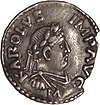
|
Charles I, the Great (Charlemagne) (742–814) |
25 December 800 | 28 January 814 | ||

|
Louis I, the Pious (778–840) |
11 September 813[10] | 20 June 840 | Son of Charles I | |

|
Lothair I (795–855) |
5 April 823 | 29 September 855 | Son of Louis I | |

|
Louis II (825–875) |
29 September 855 | 12 August 875 | Son of Lothair I | |

|
Charles II, the Bald (823–877) |
29 December 875 | 6 October 877 | Son of Louis I | |

|
Charles III, the Fat (839–888) |
12 February 881 | 13 January 888 | Grandson of Louis I | |
891–898: Widonid dynasty[edit]
| Name | Reign | Relationship with predecessor(s) | Other title(s) | ||
|---|---|---|---|---|---|

|
Guy I (?–894) |
891 | 12 December 894 | Great-great grandson of Charles I | |
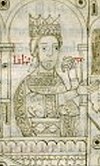
|
Lambert I (880–898) |
30 April 892 | 15 October 898 | Son of Guy I | |
896–899: Carolingian dynasty[edit]
| Name | Reign | Relationship with predecessor(s) | Other title(s) | ||
|---|---|---|---|---|---|
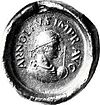
|
Arnulph (850–899) |
22 February 896 | 8 December 899 | Nephew of Charles III | |
901–905: Bosonid dynasty[edit]
| Name | Reign | Relationship with predecessor(s) | Other title(s) | ||
|---|---|---|---|---|---|
| Louis III, the Blind (880–928) |
22 February 901 | 21 July 905 | Grandson of Louis II | ||
915–924: Unruoching dynasty[edit]
| Name | Reign | Relationship with predecessor(s) | Other title(s) | ||
|---|---|---|---|---|---|

|
Berengar I (845–924) |
December 915 | 7 April 924 | Grandson of Louis I | |
Holy Roman Emperors[edit]
There was no emperor in the west between 924 and 962.
While earlier Germanic and Italian monarchs had been crowned as Roman emperors, the actual Holy Roman Empire is usually considered to have begun with the crowning of the Saxon king Otto I. It was officially an elective position, though at times it ran in families, notably the four generations of the Salian dynasty in the 11th century. From the end of the Salian dynasty through the middle 15th century, the emperors drew from many different German dynasties, and it was rare for the throne to pass from father to son. That changed with the ascension of the Austrian House of Habsburg, as an unbroken line of Habsburgs held the imperial throne until the 18th century. Later a cadet branch known as the House of Habsburg-Lorraine passed it from father to son until the abolition of the Empire in 1806. Notably, the Habsburgs were also dispensed with the requirement that emperors be crowned by the pope before exercising their office. Starting with Ferdinand I, all successive emperors forwent the traditional coronation.
962–1024: Ottonian dynasty[edit]
| Image | Name | Reign | Relationship with predecessor(s) | Other title(s) | |
|---|---|---|---|---|---|

|
Otto I, the Great (912–973) |
2 February 962 | 7 May 973 | Great-great-great grandson of Louis I | |

|
Otto II, the Red (955–983) |
25 December 967 | 7 December 983 | Son of Otto I | |
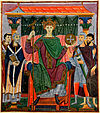
|
Otto III (980–1002) |
21 May 996 | 23 January 1002 | Son of Otto II | |

|
Henry II[note 1] (973–1024) |
14 February 1014 | 13 July 1024 | Second cousin of Otto III | |
1027–1125: Salian dynasty[edit]
| Portrait | Name | Reign | Relationship with predecessor(s) | Other title(s) | |
|---|---|---|---|---|---|
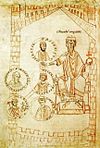
|
Conrad II, the Elder[note 2] (990–1039) |
26 March 1027 | 4 June 1039 | Great-great-grandson of Otto I | |
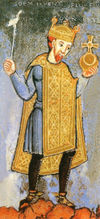
|
Henry III, the Black (1017–1056) |
25 December 1046 | 5 October 1056 | Son of Conrad II | |
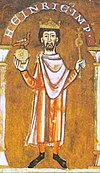
|
Henry IV (1050–1106) |
5 October 1056 | 7 August 1106 | Son of Henry III | |

|
Henry V[11] (1086–1125) |
13 April 1111 | 23 May 1125 | Son of Henry IV | |
1133–1137: Supplinburg dynasty[edit]
| Portrait | Name | Reign | Relationship with predecessor(s) | Other title(s) | |
|---|---|---|---|---|---|

|
Lothair II[note 3] (1075–1137) |
4 June 1133 | 4 December 1137 | Great-Grandnephew of Henry III | |
1155–1197: Staufen dynasty[edit]
| Portrait | Name | Reign | Relationship with predecessor(s) | Other title(s) | |
|---|---|---|---|---|---|
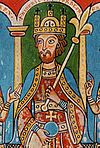
|
Frederick I Barbarossa (1122–1190) |
8 June 1155 | 10 June 1190 | Great-grandson of Henry IV | |
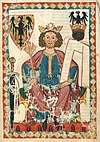
|
Henry VI (1165–1197) |
14 April 1191 | 28 September 1197 | Son of Frederick I | |
1198–1215: Welf dynasty[edit]
| Portrait | Coat of arms | Name | Reign | Relationship with predecessor(s) | Other title(s) | |
|---|---|---|---|---|---|---|
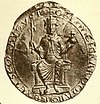
|

|
Otto IV (1175–1218) |
9 June 1198 | 1215 | Great-grandson of Lothair II | |
1220–1250: Staufen dynasty[edit]
| Portrait | Name | Reign | Relationship with predecessor(s) | Other title(s) | |
|---|---|---|---|---|---|

|
Frederick II, Stupor Mundi (1194–1250) |
22 November 1220 | 13 December 1250 | Son of Henry VI | |
The interregnum of the Holy Roman Empire is taken to have lasted from the deposition of Frederick II by Pope Innocent IV (1245, alternatively from the death of Frederick 1250 or the death of Conrad IV 1254) to the election of Rudolf I of Germany (1273). Rudolf was not crowned emperor, nor were his successors Adolf and Albert. The next emperor was Henry VII, crowned on 29 June 1312 by Pope Clement V.
1312–1313: House of Luxembourg[edit]
| Portrait | Coat of arms | Name | Reign | Relationship with predecessor(s) | Other title(s) | ||||
|---|---|---|---|---|---|---|---|---|---|
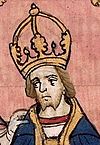
|
|
Henry VII (1274–1313) |
29 June 1312 | 24 August 1313 | Great x11 grandson of Charles II | ||||
1314–1347: House of Wittelsbach[edit]
| Portrait | Coat of arms | Name | Reign | Relationship with predecessor(s) | Other title(s) | ||||
|---|---|---|---|---|---|---|---|---|---|

|
|
Louis IV, the Bavarian (1282–1347) |
October 1314 | 11 October 1347 | Far descendant of Henry IV and great-great-great-great-grandson of Lothair II | ||||
1346–1437: House of Luxembourg[edit]
| Portrait | Coat of arms | Name | Reign | Relationship with predecessor(s) | Other title(s) | ||||
|---|---|---|---|---|---|---|---|---|---|
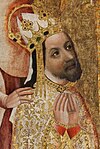
|
|
Charles IV (1316–1378) |
11 July 1346 | 29 November 1378 | Grandson of Henry VII | ||||

|
|
Sigismund (1368–1437) |
31 May 1433 | 9 December 1437 | Son of Charles IV | ||||
1440–1740: House of Habsburg[edit]
In 1508, Pope Julius II allowed Maximilian I to use the title of Emperor without coronation in Rome, though the title was qualified as Electus Romanorum Imperator ("elected Emperor of the Romans"). Maximilian's successors adopted the same titulature, usually when they became the sole ruler of the Holy Roman Empire. Maximilian's first successor Charles V was the last to be crowned Emperor.
| Portrait | Coat of arms | Name | Reign | Relationship with predecessor(s) | Other title(s) | |
|---|---|---|---|---|---|---|
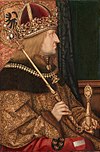
|

|
Frederick III, the Peaceful (1415–1493) |
2 February 1440 | 19 August 1493 | second cousin of Albert II of Germany, Emperor designate. | |
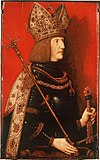
|

|
Maximilian I (1459–1519) |
19 August 1493 | 12 January 1519 | Son of Frederick III | |

|
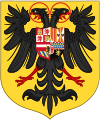
|
Charles V (1500–1558) |
28 June 1519 (crowned 1530) | 27 August 1556 | Grandson of Maximilian I | |
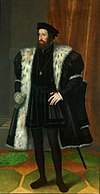
|
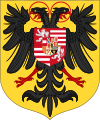
|
Ferdinand I (1503–1564) |
27 August 1556 (crowned 1558) | 25 July 1564 | Brother of Charles V | |
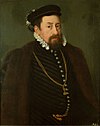
|

|
Maximilian II (1527–1576) |
25 July 1564 | 12 October 1576 | Son of Ferdinand I | |

|
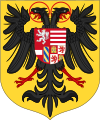
|
Rudolph II[note 4] (1552–1612) |
12 October 1576 | 20 January 1612 | Son of Maximilian II | |

|

|
Matthias (1557–1619) |
13 June 1612 | 20 March 1619 | Brother of Rudolf II | |

|

|
Ferdinand II (1578–1637) |
28 August 1619 | 15 February 1637 | Cousin of Matthias | |

|
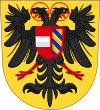
|
Ferdinand III (1608–1657) |
15 February 1637 | 2 April 1657 | Son of Ferdinand II | |

|

|
Leopold I (1640–1705) |
18 July 1658 | 5 May 1705 | Son of Ferdinand III | |

|

|
Joseph I (1678–1711) |
5 May 1705 | 17 April 1711 | Son of Leopold I | |
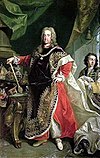
|

|
Charles VI (1685–1740) |
12 October 1711 | 20 October 1740 | Brother of Joseph I | |
1742–1745: House of Wittelsbach[edit]
| Portrait | Coat of arms | Name | Reign | Relationship with predecessor(s) | Other title(s) | |
|---|---|---|---|---|---|---|

|

|
Charles VII (1697–1745) |
12 February 1742 | 20 January 1745 | Great-great grandson of Ferdinand II; Son-in-law of Joseph I | |
1745–1765: House of Lorraine[edit]
| Portrait | Coat of arms | Name | Reign | Relationship with predecessor(s) | Other title(s) | |
|---|---|---|---|---|---|---|
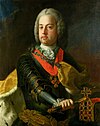
|

|
Francis I (1708–1765) |
13 September 1745 | 18 August 1765 | Great-grandson of Ferdinand III; Son-in-law of Charles VI | |
1765–1806: House of Habsburg-Lorraine[edit]
| Portrait | Coat of arms | Name | Reign | Relationship with predecessor(s) | Other title(s) | |
|---|---|---|---|---|---|---|

|

|
Joseph II (1741–1790) |
18 August 1765 | 20 February 1790 | Son of Empress Maria Theresa, de facto ruler of the empire, and Francis I. | |

|

|
Leopold II (1747–1792) |
30 September 1790 | 1 March 1792 | Son of Empress Maria Theresa,de facto ruler of the empire, and Francis I. Brother of Joseph II. | |
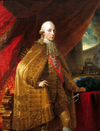
|

|
Francis II (1768–1835) |
5 July 1792 | 6 August 1806 | Son of Leopold II | |
Emperors of the French[edit]
First French Empire[edit]
| Name | Lifespan | Reign start | Reign end | Notes | Family | Image |
|---|---|---|---|---|---|---|
Napoleon I
| 15 August 1769 – 5 May 1821 (aged 51) | 18 May 1804 | 11 April 1814 | — | Bonaparte |  |
Hundred Days[edit]
Regarded as a continuation of the First French Empire despite the brief exile of the Emperor Napoleon I
| Name | Lifespan | Reign start | Reign end | Notes | Family | Image |
|---|---|---|---|---|---|---|
Napoleon I
| 15 August 1769 – 5 May 1821 (aged 51) | 20 March 1815 | 22 June 1815 | Bonaparte |  | |
| Napoleon II [12] | 20 March 1811 – 22 July 1832 (aged 21) | 22 June 1815 | 7 July 1815 | Son of Napoleon I | Bonaparte |  |
Second French Empire[edit]
| Name | Lifespan | Reign start | Reign end | Notes | Family | Image |
|---|---|---|---|---|---|---|
| Napoleon III | 20 April 1808 – 9 January 1873 (aged 64) | 2 December 1852 | 4 September 1870 | Nephew of Napoleon I Cousin of Napoleon II | Bonaparte |  |
Emperors of Austria (1804–1918)[edit]
| Name | Lifespan | Reign start | Reign end | Notes | Family | Image |
|---|---|---|---|---|---|---|
| Francis I | 12 February 1768 – 2 March 1835 (aged 67) | 11 August 1804 | 2 March 1835 | The last Holy Roman Emperor; Son of Leopold II | Habsburg-Lorraine |  |
| Ferdinand I | 19 April 1793 – 29 June 1875 (aged 82) | 2 March 1835 | 2 December 1848 (abdicated) | Son of Francis I | Habsburg-Lorraine |  |
| Francis Joseph I | 18 August 1830 – 21 November 1916 (aged 86) | 2 December 1848 | 21 November 1916 | Nephew of Ferdinand I; grandson of Francis I | Habsburg-Lorraine |  |
Charles I
| 17 August 1887 – 1 April 1922 (aged 34) | 21 November 1916 | 11 November 1918 (resigned) | Grand-Nephew of Francis Joseph I; great-great-grandson of Francis I | Habsburg-Lorraine |  |
Cite error: There are <ref group=lower-alpha> tags or {{efn}} templates on this page, but the references will not show without a {{reflist|group=lower-alpha}} template or {{notelist}} template (see the help page).
- ^ Watson, Alaric (1999). Aurelian and the Third Century. London: Routledge. ISBN 0-415-07248-4.
{{cite book}}: Cite has empty unknown parameter:|coauthors=(help) - ^ Körner, Christian (December 23, 2008). "Aurelian (A.D. 270-275)". De Imperatoribus Romanis: An Online Encyclopedia of Roman Rulers and Their Families. Retrieved January 6, 2011.
- ^ Anderson & Zinsser, Bonnie & Judith (1988). A History of Their Own: Women in Europe, Vol 1. New York, NY: Harper & Row. p. 47.
- ^ Diehl, Charles (1963). Byzantine Empresses. New York, NY: Alfred A. Knopf.
- ^ "(138) Leontius". www2.lawrence.edu. Retrieved 2019-04-17.
- ^ "Justinian II - Byzantine Coinage - WildWinds.com". www.wildwinds.com. Retrieved 2019-04-17.
- ^ "Philippicus - Byzantine Coinage - WildWinds.com". www.wildwinds.com. Retrieved 2019-04-17.
- ^ "Anastasius II - Byzantine Coinage - WildWinds.com". www.wildwinds.com. Retrieved 2019-04-17.
- ^ "Theodosius III - Byzantine Coinage - WildWinds.com". www.wildwinds.com. Retrieved 2019-04-17.
- ^ Egon Boshof: Ludwig der Fromme. Darmstadt 1996, p. 89
- ^ Barraclough, Geoffrey (1984). The Origins of Modern Germany. W. W. Norton & Company. ISBN 978-0-393-30153-3.
- ^ From 22 June to 7 July 1815, Bonapartists considered Napoleon II as the legitimate heir to the throne, his father having abdicated in his favor. However, the young child's reign was entirely fictional, as he was residing in Austria with his mother. Louis XVIII was reinstalled as king on 7 July.
Cite error: There are <ref group=note> tags on this page, but the references will not show without a {{reflist|group=note}} template (see the help page).
| This is the discussion page for an IP user, identified by the user's IP address. Many IP addresses change periodically, and are often shared by several users. If you are an IP user, you may create an account or log in to avoid future confusion with other IP users. Registering also hides your IP address. |







